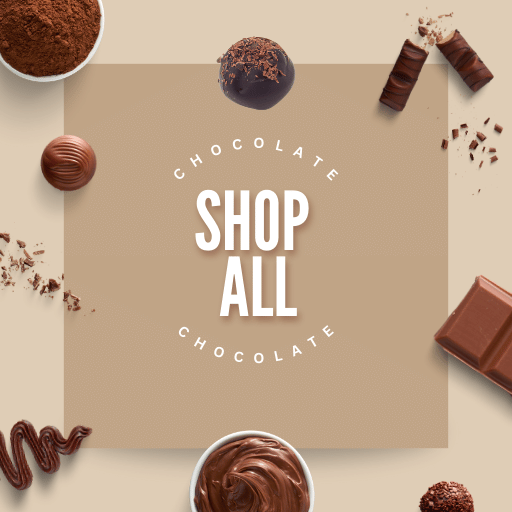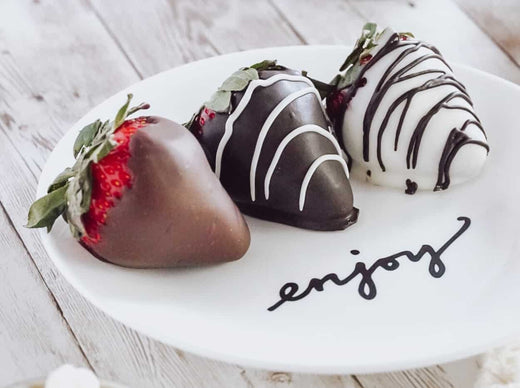Most people have a deep and long-standing affection for chocolate that goes back to early childhood memories.
From comforting hot cocoa on a chilly winter evening to refreshing ice cream on a summer’s day at the seaside, it's an integral part of our culinary lives.
But how well do we really know our favourite indulgence?
With an array of flavours, textures, and cocoa percentages, the world of chocolate is as varied as it is delicious.
This post will guide you through the different types of chocolate, shedding light on their unique characteristics, origins, and uses.
So, let's embark on this cocoa-filled adventure together!
A List of the Different Types Of Chocolate
-
Dark Chocolate: Also known as "plain chocolate", dark chocolate is made from cocoa solids, cocoa butter, and sugar. It has a rich, robust flavour due to a high proportion of cocoa solids, usually ranging from 70% to 100%. Dark chocolate is loved for its intense taste and health benefits, as it's packed with antioxidants. It's often used in baking, confectionery, and desserts for a deep, chocolaty flavour.
-
Milk Chocolate: The most popular type of chocolate in the UK, milk chocolate includes milk powder or condensed milk in addition to cocoa solids, cocoa butter, and sugar. This gives it a sweeter, creamier taste compared to dark chocolate. Milk chocolate must contain at least 20% cocoa solids and 20% milk solids, but this can vary by brand. It's perfect for snacking, cooking, and baking.
-
White Chocolate: Unlike other types, white chocolate contains no cocoa solids, only cocoa butter, sugar, and milk. This results in a sweet and creamy product that lacks the bitterness associated with cocoa solids. It's often used in desserts, confectionery, and baking where a milder, sweeter chocolate is desired.
-
Ruby Chocolate: This is a relatively new type of chocolate, first introduced in 2017. Ruby chocolate is made from specially selected ruby cocoa beans, which give it a natural pink colour and a unique fruity, slightly sour taste. It's great for snacking and decorating desserts, and is becoming increasingly popular in gourmet chocolate products.
-
Couverture Chocolate: This is a high-quality chocolate with a higher percentage of cocoa butter (around 32-39%). It melts smoothly, making it ideal for coating, dipping and moulding in professional chocolate-making.
-
Unsweetened Chocolate: Often referred to as baking or bitter chocolate, this is pure chocolate liquor, made solely from ground cocoa beans. It has a strong, bitter taste and is usually used in recipes with added sugar.
-
Compound Chocolate: This is a lower-cost chocolate substitute, often used in commercial baking. It contains vegetable fats instead of cocoa butter, which makes it easier to work with but lacks the same depth of flavour as real chocolate.
-
Cacao Nibs: These are crushed pieces of cacao beans. They have a bitter, chocolatey flavour and are often used as a topping or mixed into baked goods for a crunchy texture and intense cocoa hit.
Remember, the best chocolate for you is the one you enjoy the most, whether that's luxurious dark chocolate, creamy milk chocolate, or unique ruby chocolate.
Experiment and explore to find your personal favourite!
Related Post: What is Cocoa Mass?
What Are the Most Common Types of Chocolate?
When we look into the tempting world of chocolate, three types typically stand out due to their widespread popularity and use in a range of culinary applications.
These are dark, milk, and white chocolate.
Dark Chocolate
This variety is often appreciated by chocolate connoisseurs due to its deep, intense flavour.
With a high percentage of cocoa solids (typically ranging from 70% to 100%), dark chocolate provides a richness and complexity not found in other types.
In addition to being enjoyed as a stand-alone treat, it's widely used in baking and desserts for an indulgent cocoa hit.
Milk Chocolate
Undeniably the favourite amongst UK chocolate lovers, milk chocolate combines cocoa solids, cocoa butter, sugar, and milk (in the form of milk powder or condensed milk).
The addition of milk lends a creamier, smoother, and sweeter taste than its dark counterpart, making it a versatile choice for confectionery, baking, or a simple snack.
White Chocolate
Contrary to dark and milk chocolate, white chocolate contains no cocoa solids at all.
Instead, it's made up of cocoa butter, sugar, and milk, resulting in a creamy, sweet, and mild flavour.
It's often used in confectionery and desserts that call for a subtler chocolate note.
While these three types of chocolate are the most common, the world of chocolate is vast and varied.
From the naturally pink and fruity ruby chocolate to the luxury of couverture chocolate, there's a chocolate out there to suit every palate.
Nonetheless, dark, milk, and white chocolate remain the staples of our chocolate consumption, each offering a unique and delectable taste experience.
Related: Can You Eat Cooking Chocolate?
Which is the Most Popular Type of Chocolate in the UK?
When it comes to the favourite chocolate type in the UK, milk chocolate undoubtedly takes the crown.
With its smooth, creamy texture and sweet flavour, it's a hit with both adults and children alike.
Many of Britain's best-loved chocolate bars are all variations of milk chocolate, which perhaps gives us some insight into its widespread popularity.
While dark chocolate, with its richer, more intense flavour profile, and white chocolate, known for its sweet, creamy notes, do have their fans, it's the irresistible charm of milk chocolate that continually wins over the UK's chocoholics.
However, it's worth noting that the trend for darker chocolate has been growing as people increasingly seek out more premium, high-cocoa-content chocolates.
These are often seen as more 'gourmet' and have health benefits attributed to them due to their higher cocoa content.
Regardless, as it stands, milk chocolate remains the UK's top choice.
Related Post: What is Cocoa?
Where Can You Buy a Variety of Different Types of Chocolate?
For those seeking to indulge in an assortment of different types of chocolate, look no further than Whitakers Chocolates.
A family-run business for over 135 years, we have been refining and perfecting our craft across all ranges, be it dark, milk, or white chocolate.
With our rich heritage and experience, we've created a delicious selection to cater to all palates.
Whether you fancy the bold, intense richness of plain dark chocolate or prefer something with a touch of fruity zest, we've got you covered.
We are committed to producing our chocolates using only pure, natural ingredients.
We believe in delivering a clean, delicious product, so you can rest assured that no artificial additives find their way into our chocolates.
For those with dietary restrictions, we haven't forgotten about you.
We've developed a variety of options for those following a gluten-free diet.
Also, our entire range of dark chocolate products is proudly registered with The Vegan Society, making them a perfect treat for those following a plant-based lifestyle.
No matter your preference or dietary requirements, you're certain to find a chocolate delight to suit your taste at Whitakers Chocolates.
Experience our commitment to quality, variety, and above all, the art of chocolate making today.
Here are a few of our firm favourites:
- Milk chocolate gold foiled hearts tubs
-
Orange and Lemon infused dark chocolate fondant creams
- Milk chocolate and honeycomb pieces flavoured with Smoky Salted Caramel
- Hand-finished white chocolate and champagne chocolate truffles
Some Notes From an Expert Chocolatier
While there are many exciting and exotic types of chocolates coming into the market, like ruby chocolate or raw chocolate, nothing quite beats the timeless trio: dark, milk, and white.
As an expert chocolatier, I've seen the trends come and go, but these three stalwarts of the chocolate world have never lost their allure.
Each has a unique character and profile that can satisfy different moods, preferences, and occasions.
Personally, I have a deep fondness for dark chocolate.
Its depth of flavour, combined with its known health benefits, make it a delicious and wholesome treat.
Believe it or not, I indulge in a few squares every day!
Packed with nutrients and antioxidants, dark chocolate complements my active lifestyle and commitment to healthy eating.
But let's not forget about milk chocolate.
It's creamy, comforting, and universally loved - a little bit of milk chocolate now and then is a true delight.
And while white chocolate isn't my preferred choice due to its unique flavour profile, I appreciate its creamy texture and sweetness that many chocolate lovers adore.
Ultimately, the beauty of chocolate lies in its diversity.
There is a type of chocolate out there for every palate, every mood, and every occasion.
So whether you're a dark, milk, or white chocolate aficionado, rest assured, there's always a chocolate out there waiting for you to savour and enjoy.
Final Notes On the Different Types Of Chocolate
While there are many exciting and exotic types of chocolates coming into the market, like ruby chocolate or raw chocolate, nothing quite beats the timeless trio: dark, milk, and white chocolate.
As an expert chocolatier, I've seen the trends come and go, but these three stalwarts of the chocolate world have never lost their allure.
Each has a unique character and profile that can satisfy different moods, preferences, and occasions.
There is a type of chocolate out there for every palate, every mood, and every occasion.
So whether you're a dark, milk, or white chocolate aficionado, rest assured, there's always a chocolate out there waiting for you to savour and enjoy.











